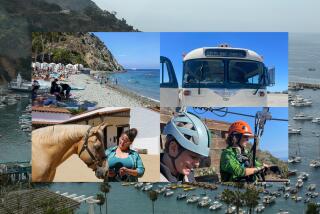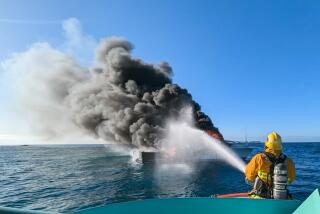Sales Sinking at Catalina Yachts : Recession: Despite a 35% drop, the Woodland Hills company may be able to ride out the poor economy while other firms founder.
Frank Butler founded Catalina Yachts in 1970 because he wanted to “come out with sailboats of a design that could be affordable.”
Butler thought he’d achieved that goal with Catalina’s first boat, a 22-footer, and figured that he’d be happy if he eventually sold 300 of the boats. Twenty-two years later, the Woodland Hills-based company has sold more than 50,000 boats, from eight-foot models that sell for a little more than $1,000 to 50-foot yachts with $250,000-plus price tags. Catalina is now widely acknowledged as the nation’s largest sailboat builder, as measured by the number of boats sold, and the company is second in the world to France’s Beneteau, according to the National Marine Manufacturers Assn., a Chicago-based trade group.
Butler’s strategy has been to sell sturdy but relatively low-priced boats--the Buicks of the sailboat world rather than the BMWs. “The thing that sets Frank Butler apart is he has always tried to give people a good value,” said Dan Spurr, editor of Practical Sailor, a trade magazine.
But Catalina, like the rest of the sailboat manufacturing industry, has been buffeted recently by the recession, a 1990 luxury tax on boat purchases and a growing indifference by time-pressed yuppies to the rigorous sport of sailing. The company’s sales have sunk 35% in the past two years to about $33 million a year, from more than $50 million a year at its peak. And the number of boats the company builds each year has declined from 4,000 to between 2,200 and 2,500, said Butler, the company’s sole owner.
Last year, Catalina laid off 350 workers--more than 40% of its work force--at its two plants in Woodland Hills and Florida as orders for its biggest yachts plunged. “I wouldn’t say we’re losing money, but we’re not making money,” Butler said.
Catalina isn’t alone. Sales of non-powered sailboats in the United States plummeted to 18,800 in 1990 from 73,000 in 1981, according to the manufacturers association. As a result, many sailboat makers have been forced into bankruptcy or have closed permanently.
Among the victims: Pearson Yachts, one of the nation’s oldest makers of fiberglass sailboats, which was split up and sold in bankruptcy court in Rhode Island last year; Shannon Boats, which filed for bankruptcy court protection in 1989, and Sabre Yachts, which closed in February after the company lost its credit line. Greg Proteau, a manufacturer’s association spokesman, estimated that the U.S. sailboat industry has lost at least a third of its manufacturers in the past few years.
While other companies are drowning, however, Catalina might just stay afloat. The reason is that the same strategy that fueled Catalina’s growth in its earlier days--selling relatively inexpensive boats--might now be its lifeline.
“It’s the kind of boat that you can step into without selling the farm, but you’re still stepping into a decent boat,” said Quentin Warren, associate editor of Cruising World magazine.
Even Catalina’s most expensive sailboat, which might sell for about $300,000, is a relative bargain, said Rick Weisenberger, a Newport Beach yacht broker. A comparable custom-made boat could easily be priced at $500,000 to $750,000, he said.
Butler said he’s able to sell his boats more cheaply because he keeps his overhead down. Catalina boats are mass produced according to standardized designs; a 36-foot boat, for instance, can be built in just 11 days. The company makes its own cushions and keels, does its own rigging and cuts and stitches sails according to computerized patterns. Catalina’s offices are modest, and the company does no national advertising, selling its boats through a network of about 150 dealers nationwide.
Catalina is not without critics, however. Spurr at Practical Sailor said Catalina’s boats aren’t suitable for long offshore ocean voyages and the hulls on some boats are relatively thin. “It’s a lightweight boat,” he said. “They are low in price and no matter how you cut it, the quality has to be reflected in that.”
But Weisenberger argued that Catalina shouldn’t be compared to its higher-priced rivals. Butler “has never purported to deliver the best boat,” he said. “He says he makes the best boat for the money. Not too many people would argue with that.”
And if many Catalina boat owners are unhappy with their vessels, Donald Kerlin, chief of recreational boating at the U. S. Coast Guard’s product assurance branch, has yet to hear of it. In an informal search through the Coast Guard’s database, Kerlin found about half a dozen complaints made against Catalina in the past decade, most for hull blistering--a defect common to many types of boats. Most of the problems were fixed by Catalina.
“On the basis of that, I certainly wouldn’t think they’re a problem company,” Kerlin said.
Still, industry insiders say that Butler bristles at the suggestion that his boats are anything but the best quality. Spurr of Practical Sailor said that when he has published articles criticizing Catalina boats, he has immediately received calls or letters from Butler or an attorney representing Catalina threatening litigation. “We have to be very careful whatever we say about Frank Butler,” Spurr said.
Butler, 64, who admits to a general lack of diplomacy--”I tell people what I think,” he said--was born in Glendale and in his younger days owned a machine shop. In the early 1960s, when an acquaintance he hired to build a sailboat for him failed to deliver, Butler decided to construct his own boat.
After that, he was hooked. Working nights in his machine shop, Butler started taking orders for sailboats “and before I knew it the company was growing and growing.” Butler said he sold that company in the late 1960s and subsequently started Catalina.
In the past several weeks, Butler said he’s noticed that business has begun picking up slightly, possibly because President Bush has proposed repealing the 10% tax on boats priced over $100,000 that has been widely blamed for wiping out sales of higher-priced boats. Butler said he’s begun hiring again, but remains cautious about the future.
The industry “will never go back to where it was,” Butler said.
Others agree that sailboat builders might never match the sales levels they once enjoyed. One reason, said Spurr, is that today’s fiberglass sailboats don’t wear out quickly, and used boats can be had for less money than new ones. Another is that affluent baby boomers haven’t taken to sailing as much as past generations, possibly because so many other forms of recreation compete for their time.
Despite the industry’s slowdown, Brad Buettner, co-owner of Stan Miller Yachts, a large boat dealer in Long Beach, said that among sailboat builders, Catalina “would be considered hands down the strongest financially.”
Catalina is also now sailing in far less crowded waters. “When competitors go away, you pick up market share,” said the Proteau of the manufacturer’s association.
And you pick up competitors. As other boat builders have foundered, Catalina has acquired some of their assets. One of its most significant acquisitions was its purchase a few years ago of Morgan Marine, which gave Catalina its Florida plant and allowed it to expand into building bigger, easy-to-sail yachts.
Butler has also bolstered Catalina’s reputation by building 11 custom boats for the famous Congressional Cup race sponsored by the Long Beach Yacht Club. And lately he’s been pushing harder into foreign markets, which previously accounted for a tiny percentage of Catalina’s total sales.
Will Catalina survive? “If we don’t have the market there that was before, we just have to work harder,” Butler said. “If we can get through it, I feel we’ll have a stronger company.”
More to Read
Inside the business of entertainment
The Wide Shot brings you news, analysis and insights on everything from streaming wars to production — and what it all means for the future.
You may occasionally receive promotional content from the Los Angeles Times.











